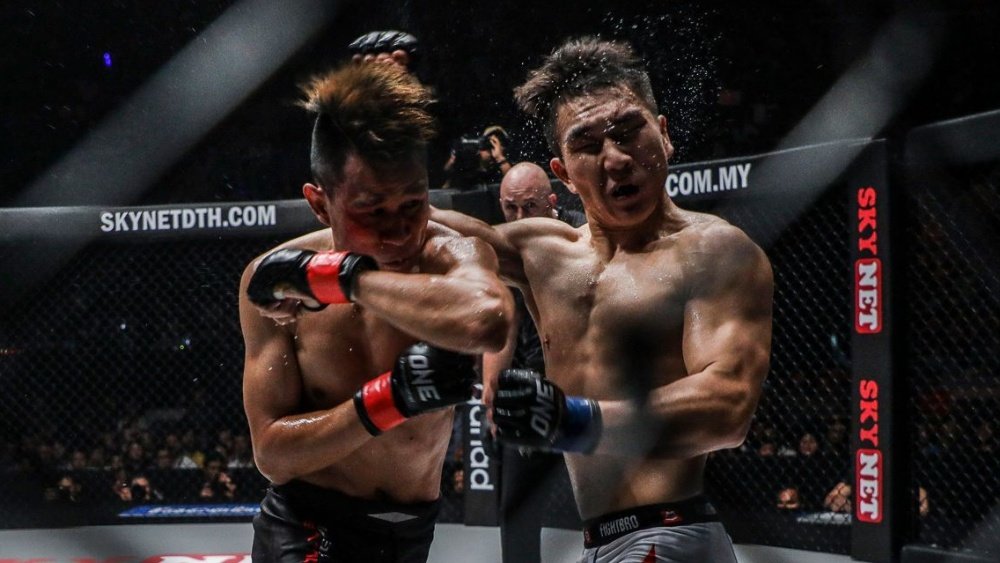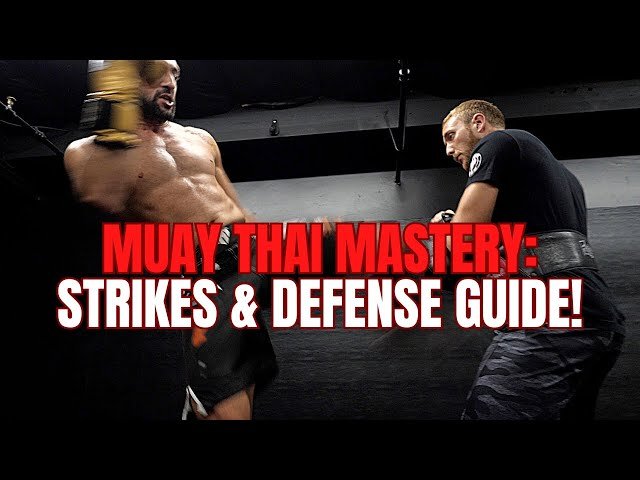Contents
- 1 Introduction
- 1.1 Mastering Essential Muay Thai Striking Techniques
- 1.2 How to Maximize Impact and Damage with Strikes
- 1.3 Essential Muay Thai Combos to Cripple Any Opponent
- 1.4 Advanced Offensive Muay Thai Skills and Strategies
- 1.5 How to Develop One-Punch KO Power
- 1.6 Integrating Offense and Defense
- 1.7 Conclusion
- 1.8 FAQs
Introduction
Developing strong offensive skills is arguably the most vital aspect of excelling in Muay Thai. Most fights are won based on superior striking prowess leading to knockouts or technical knockouts from an accumulation of devastating blows. Mastering the hardest hitting punches, elbows, knees and kicks – along with fluidly transitioning between them – enables a fighter to overwhelm and dominate the opposition.

This comprehensive guide delves deep into essential Muay Thai offensive techniques. You’ll learn proper striking mechanics, high percentage combinations, advanced set up skills, developing fight-ending power, and seamlessly blending offense with defense. Integrating these concepts into training will equip any fighter with the dynamic attacking arsenal needed to emerge victorious.
Mastering Essential Muay Thai Striking Techniques
Before unleashing fight-altering combinations, every MMA striker must first establish mastery over fundamental offensive skills. This entails proper striking technique encompassing stance, rotation, transferring weight correctly between base and rear, and generating maximum force.
Proper Striking Stance and Mechanics
The foundation begins with a balanced fighting stance, allowing for fluid movement and strike delivery:
- Feet shoulder-width apart, lead foot pointed at opponent
- Weight evenly distributed or slightly towards back leg
- Lead arm extended towards opponent, rear guarding head
- Light on toes to enable dynamic movement
- Head off centerline, torso bladed
When executing any Muay Thai strike, several key principles apply:
- Rotate hips and torso to transfer weight into the strike
- Pivot lead foot for additional momentum
- Snap technique at point of impact for more force
- Return to guard quickly after striking
Mastering these mechanics and finding optimal foot positioning for leverage amplifies the effectiveness of every Muay Thai weapon.
Essential Muay Thai Arm Strikes
Along with kicks, punches comprise a significant portion of Muay Thai striking offense. Key aspects include:
- Straight punches – the jab and cross
- Power hand punches – lead and rear hooks, uppercut
| Punch Type | Key Details |
|---|---|
| Jab | Fast, used to gauge distance and set up combinations |
| Cross | Delivered with rear hand, generates knockout power |
| Lead Hook | Often aimed at liver or floating ribs |
| Rear Hook | Power shot to temple, jaw or side of head |
| Uppercut | Launched in close quarters to attack chin or solar plexus |
Elbow strikes also inflict immense trauma. Primary elbows include:
- Horizontal elbow – slices across opponent’s head
- Diagonal elbow – follows same trajectory as cross
- Uppercut elbow – attacks from below to impact chin or torso
Knee strikes typically require a body lock or clinch position first before attacking:
- Straight knee – lifts directly into abdomen when clinched
- Diagonal knee – targets ribs, thighs, torso
Essential Muay Thai Kick Types
Along with the heavy artillery provided by knees and elbows, kicks complete the well rounded striking skill set for Muay Thai specialists:
- Roundhouse kick – arcs sideways, often aimed at ribs or thighs
- Straight teep – front thrust kick to opponent’s torso
- Oblique kick – lands along outer edge of shin targeting knees or legs
Each essential technique serves a specific tactical purpose in dismantling the opposition. Mastery emerges from thousands of precise repetitions to ingrain mechanics while developing fluidity and timing.
How to Maximize Impact and Damage with Strikes
Beyond technical proficiency, offensive success requires intelligently targeting areas that inflict maximum trauma. Understanding key principles magnifies the likelihood of causing damage that drastically alters the complexion of a fight:

Target Vulnerable Anatomical Structures
When striking with brutal intent, aim for locations enabling the greatest physiological impact:
- Head – temporal bone, jawline, nose and chin cause loss of consciousness when struck effectively
- Torso – solar plexus, liver, spleen, kidneys and floating ribs compromise opponent’s stability
- Legs – impair mobility while limiting opponent’s striking base
Condition Tools to Harden Weapons
Sharpening elbows, knees, shins and knuckles transforms them into lethal weapons:
- Temper shins by routinely striking heavy bags, pads and arms
- Use traditional Muay Thai clay for elbow conditioning
- Knee cartilage and knuckle integrity benefits from calcium supplementation
Time Strikes Strategically
Beyond sheer power, offensive success hinges extensively on timing:
- Attack when opponent is off-balance or transitioning stances
- Target exits as opponent moves straight back from exchanges
- Capitalize on openings created from evading opponent’s missed strikes
Sequencing combinations against a defensively compromised opponent spells doom.
Set Up Strikes Intelligently
Both primary attacks and counters depend on crafty set ups:
- Use feints to gauge reactions and create openings
- Implement angles and lateral movement to find holes
- Allow opponents to walk themselves into traps
Combat sports icon Fedor Emelianenko, renowned for his calculated aggression, conceded: “My experience informs me that the most dangerous moments are when I capitalize on my opponent’s errors.”
Transfer Maximum Bodyweight into Strikes
Generating knockouts requires harnessing total body mass via proper mechanics:
- Rotate hips and shoulders fully to accumulate momentum
- Time forceful hip rotation into impact instances
- Pivot lead foot to added body rotation
With precise technique and sufficient conditioning, even average sized strikers can unravel far larger opponents.
Essential Muay Thai Combos to Cripple Any Opponent
Fluid combinations overwhelm opponents mentally while dishing out game changing punishment. Training repetition ingrains go-to combo patterns while diversifying attacks:
Why Combinations Matter
- Forces opponents to defend layered attacks from all angles
- Overloads sensory reaction and processing capacity
- Allows capitalization as opponents freeze, flinch or drop hands
Keys to Executing Combos
- Condition sequences into muscle memory via pads and bag work
- Use initial strikes to manipulate defenses, create openings
- Vary targeting – alternate legs, body, head continuously
- Time closing strikes as opponents attack (intercepting)
Vital Anatomical Target Areas
Aim to land series of unanswered blows targeting:
- Head – cumulative trauma leads to TKO stoppage
- Torso – break down core stability, wind opponent
- Front leg – impair mobility which limits offense
Bread and Butter Muay Thai Combinations
Having sequences ingrained through training repetition offers numerous tactical advantages:
- Lead leg round kick to rear cross punches
- Jab, cross, left body kick
- Clinch right knee tap, left horizontal elbow
- Double jab, right low kick, left body kick
- Inside leg kick, cross counter right hook
- Rear uppercut elbow, right knee, left elbow horizontal
- Outside leg kick, step across diagonal knee
- Straight right cross counter off rear foot
- Lead hand barrage – double jab, hook, exit with angle
- Body kick, right straight to left shovel hook
Continue diversifying combinations tailored to personal style – the key lies in conditioning through thousands of reps.
Advanced Offensive Muay Thai Skills and Strategies
Transforming from competent striker to truly dominant force demands more than athletic attributes or rudimentary technique alone. Implementing next level tactics and adaptive strategy separates the apex predators from the rest of the pack:
Bait Opponents into Counters
Elite strikers invite aggressive attacks, having already planned a tailored response:
- Present false openings to draw specific committed attacks ✅
- Allow opponents to overextend while remaining defensively responsible
- Capitalize on holes opened from missed strikes with precision counters
This exemplifies highest level fight IQ – envisioning sequences before they develop.
Apply Intelligent Pressure
Forward pressure fighters apply unrelenting offense while still maintaining tactical responsibility:
- Use non-stop pumping jab to gauge reactions and set up shots
- Rip constant hard leg kicks to impair mobility
- Vary vertical attacks – alternate between head and torso targeting
- Condition pressure fighting until second nature
This style overwhelms both physically and psychologically.
Master Set Up Strikes
Top fighters landed their most damaging shots off intelligent set ups and entry angles:
- Use initial strikes to alter opponent’s vision and balance
- Exit exchanges at angles ripe for explosive counters
- Hide power hand loading motions before unveiling them
Deception and anticipation trumps naked aggression.
Punish Wounded Prey
When an opponent is genuinely hurt, ruthless finishers smell blood in the water – instantly attacking without mercy.
- Swarm reeling opponents before they regain their wits
- Attack legs and torso to further flatten damaged foes
- Unload vicious ground strikes when opponent already woozy
Killer instinct demands a predator’s mentality.
Adapting Offense Strategically
Fights constantly evolve – what works early may fail later. Championship caliber strikers pivot tactics as needed:
- Recalibrate range and tempo if initial approaches ineffective
- Target fresh openings revealed in ensuing rounds
- Double up on successful weapons already landed
- Implement takedowns if struggling with opponent’s length
Offensive flexibility provides an ultimate edge when mastered.
How to Develop One-Punch KO Power
Generating authentic one-punch knockout power accelerates the path to fight endings. While partially genetic, knockout power also hinges heavily on technical mastery and physics:
Understand Knockout Physics
- Mass of striking tool (fist) + Bodyweight moving behind it = Impact Force
- Tripling fist velocity doubles impact force
- Perfectly timed chin contact imparts tremendous g-forces
Optimize Body Mechanics
- Transfer 100% body mass into pendulum-like striking motion
- Achieve full hip/torso rotation driving through contact
- Refine punch trajectory targeting optimal chin angle
Condition Functional Muscles
- Strengthen anterior/posterior chains
- Train explosiveness to maximize striking speed
- Use weight vests, resistance bands, medicine balls
- Develop core stability for better weight transfer
Mastery Through Repetition
- Ingrain neural pathways for key weapons like cross counter
- Interval training with rounds on pads, heavy bag, double ended bag
- Consistently visualize knockouts between training sessions
Target Weak Areas
- Radar closed defensive holes as opportunities open
- Draw out predictable patterns to exploit
- Create damage early that agrees with natural tendencies
The greatest challenge lies in summoning physical gifts amidst bright lights without hesitation. This separates champions from those left wondering “what if”.
Integrating Offense and Defense
Well rounded striking proficiency manifests when offense and defense merge into an interchangeable flowing spectrum. Even amidst heated exchanges, the upper echelon never abandons all defensive responsibility. Integrating set ups, counters and evasiveness optimizes damaging output while minimizing received strikes.
Calculated Aggression
Recklessness gets fighters hurt – the most effective aggression maintains built-in safety valves:
- Remain defensively responsible when uncorking combination barrages
- Create angles permitting exits after sustained exchanges
- Keep guard tight during forward assaults in case opponents counter
- Don’t abandon legs/body work despite head hunting
Precise Counterstriking
Attempting to strike freely while never getting hit is unrealistic. Elite strikers accept receiving blows at times. They excel based on tailored counter offense in between:
- Allow opponents to lead, capitalizing on counter windows
- Identify signature go-to weapons to exploit
- Time intercepting knees/elbows against rushing attackers
- Condition counter sequences into instinctual reactions
Slip and Return Combos
Defensive gems emerge from refined shoulder/head movement allowing strikers to make opponents miss before responding:
- Master nuances of slipping punches and exiting safely
- Throw counters almost simultaneously utilizing residual momentum
- Target damage wherever openings emerge after initial evasions
Intelligent Guarding
Despite refined defensive skills, blows inevitably land. Minimizing damage preserves longevity:
- Keep guard tight, prioritize protecting head/chin
- Deflect/absorb body kicks with elbows down
- Roll with punches using slightly early evasion
Offense From Defense
Elite technicians seamlessly transition between attacking and defensive modes interchangeably – often within fractions of a second. This unpredictability keeps opponents perpetually off balance, enabling dominant performers to seize momentum through scoring while nullifying counter chances.
Conclusion
Developing dangerous, fight ending offense requires far more than raw talent.True mastery emerges from combining physical attributes with technical soundness, tactical savvy and killer instinct.
Use this guide to elevate stand up skills across every key striking realm – essential tools, combination sequencing, advanced strategy and defensive integration. Applying these offensive concepts will overwhelm opponents, leading to ruthless fight-ending efficiency. Just remember, striking defense can never fully be abandoned.
- Read More on Evolve!
- Read Next on Legacy and Legend: The Greatest Muay Thai Champions and Their Fighting Styles Explained
FAQs
Here are the top 30 most asked FAQs for this blog post on mastering Muay Thai offense:
What is the most important fundamental skill to develop?
Proper striking technique including footwork, hip rotation, torso positioning, and keeping guard tight.
What target areas cause the most damage?
Head – jawline, chin, temples, back of ears. Ribs, kidneys and liver also extremely vulnerable.
How can I hit harder and knock people out?
Generating more force requires hip/torso rotation, lead foot pivot on impact, snapping techniques at point of contact.
What muscles should I strengthen for maximal striking power?
Core, hips, shoulders and anterior/posterior chain. Plyometrics develops striking speed strength.
What are the best Muay Thai combinations to practice?
Ones targeting different levels fluidly – legs, body and head. Ex: Body kick to right cross, shovel hook finish.
How do I set up knockout punches better?
Use angles, feints and initial strikes to manipulate vision/balance. Hide power hand loading motions.
What workout equipment is best for improving strikes?
Heavy bags, double end bag, resistance bands/tubing, medicine balls, weight vests.
Should I prioritize offense or defense?
Strikers need both. Recklessness gets countered. Remain defensively responsible even amidst aggressive flurries.
How do I make an opponent miss then capitalize?
Master shoulder/head slip nuances then counter off residual momentum. Requires precision timing.
What strategies are best against tough pressure fighters?
Use distance weapons like oblique kicks and straight punches. Check hook counters discourage forward bursts.
How do I adapt my offense round to round?
Identify new holes revealed, double up on already successful weapons, change tempo/range if needed.
What striking defense principles apply amidst exchanges?
Keep guard tight, roll with shots to absorb impact, use elbows to deflect kicks.
How often should I train different striking techniques?
Daily padwork and bag routines with plenty weekly sparring integrating both offense and defense.
What tactics create openings against defensive fighters?
Use set up strikes to manipulate guard, feint reactions, allow opponents to walk into traps.
How do I develop confidence landing techniques in fights?
Through mastery in training by ingraining key weapons into muscle memory via visualization and repetition.
What strategies help when hurt or gassed late in fights?
Re-establish jab, catch breath in clinch, target fresh openings, bait opponents into counters.
How do I recover when dropped or stunned by strikes?
Create space and time with long guard and lateral movement. Regain wits before re-engaging.
What conditioning best replicates fight intensity?
Interval pad rounds with coach, situational sparring, high-pace heavy bag rounds focused on form.
How do I avoid tensing up during fights?
Trust preparation. Visualize sequences. Establish smooth rhythm early utilizing fundamentals.
What tactics maximize damage when opponent is hurt?
Immediate swarming with combinations before recovery. Doubles up on already successful shots.
How do I become more unpredictable offensively?
Set opponents up multiple ways by variance of combinations, timing, angles and footwork.
What causes late fight stagnation despite early success?
Failing to adapt to opponent’s mid-fight adjustments. Requires recalibrating preferred range/tempo.
What weaknesses to exploit against Muay Thai strikers?
Test their boxing defense, double up rear leg round kicks, use reactive takedowns against their kicks.
How important is muscular strength for knockout power?
Somewhat important – but technique, speed and timing matters more than size/strength advantages alone.
What should I do if struggling with opponent’s reach?
Use kicks/knees from distance, clinch entries, catch and pitch opportunities to negate length.
Why do my early fights seem more effortless?
Adrenaline offsets fatigue but leads to reckless abandon later. Composure, calculated aggression and preparation prevents this.
How do I resist brawling when hurt despite wanting to?
Have coach remind you to establish fundamentals – safe range, circled movement and 1-2 punches – until recovered.

[…] Read Next on Mastering Muay Thai Offense: In-Depth Techniques for Devastating Strikes and Combos […]